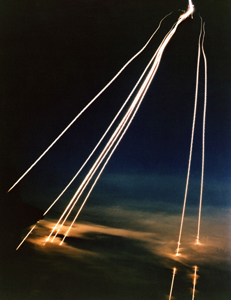In its Nuclear Posture Review, DOD unveiled its decision to convert all Minuteman IIIs into single-warhead ICBMs. Today, USAF has 450 of them. Many have one warhead, but some are “MIRVed,” meaning their nosecones have multiple independently targetable re-entry vehicles. These have up to three warheads.
Not for long, though, as plans call for USAF to “de-MIRV” them all. “This step,” claimed the NPR, “will enhance the stability of the nuclear balance by reducing the incentives for either side to strike first.”
How will “downloading” US silo-based missiles substantially reduce the nuclear threat? In weighing the answer, it is useful to review some history.
Writing in 1953 about the two nuclear superpowers, J. Robert Oppenheimer, former scientific director for the Manhattan Project (turned harsh nuclear critic), observed, “We may be likened to two scorpions in a bottle, each capable of killing the other, but only at risk of his own life.”
 |
MIRVs: Too much of a good thing.
|
In the 1950s and 1960s, though, weapons were inaccurate. Because one had to commit several weapons to be sure to cover a single target, the attacker would run out of weapons before he wiped out the enemy’s nukes. The foe’s second strike was assured, so neither side wanted to go first.
MIRVing upset that stability. The US flight-tested a MIRVed system in 1968 and began deploying the triple-warhead Minuteman III in 1970. The USSR soon followed, catching and up with and then far surpassing the US by the early 1980s. On both sides, accuracies sharpened, too.
As MIRVed ICBMs proliferated, Oppenheimer’s scorpions-in-a-bottle metaphor moved closer to reality, for two reasons:
Capability. Stacking multiple warheads on each missile dramatically increased each ICBM’s firepower and its usefulness in mounting a disarming counterforce strike. An attacker could fire off a portion of his own ICBM force while still keeping some in reserve.
Incentive. Missiles with many warheads instantly became lucrative targets. A single enemy silo might now hold three, six, or more warheads. Even if an attacker had to expend two warheads per silo, the offense would still enjoy the benefits of a favorable exchange ratio.
It was this push-pull combination that made the late Cold War nuclear balance precarious. In a crisis, either side—though still very fearful—might be tempted to go first in hopes of gaining a war-winning advantage.
One of the great ironies of the times was the central role played by arms control in promoting this upward spiral of nuclear danger. While the superpowers probably would have gone MIRV at some point, that day was hastened by SALT talks in the late 1960s. The push was to limit launchers—bombers and missiles—not warheads. The logical response was to make the fullest use of each launcher by piling on warheads.
Arms negotiator Paul C. Warnke memorably, and mistakenly, compared the superpowers to “apes on a treadmill,” with both “jogging in tandem on a treadmill to nowhere.” There was only one ape, though. Former Defense Secretary Harold Brown had it right when he said, “When we build, they build; when we stop building, they build.”
According to Natural Resources Defense Council estimates, the US and Soviet Union in 1975 each had roughly 2,200 warheads atop their ICBMs.
Over the next five years, the US total didn’t change, but Moscow more than doubled its MIRV force, winding up with 5,630 warheads fitted to its 1,400 or so land-based missiles. A huge number of these—more than 3,000 warheads—were found on the monster, 10-warhead SS-18 missiles. The Soviets had 308 of them.
In Western strategic circles, it was thought that the SS-18 force was powerful enough to destroy 65 to 80 percent of US ICBM silos, using two nuclear warheads against each, with more than 1,000 SS-18 warheads left over for further counterforce strikes.
Over time, as the arsenals grew, officials began to see the drawbacks of MIRVing, while it became clear single-warhead ICBMs were actually stabilizing. Such weapons reversed the push-pull dynamic set in motion by MIRVing.
“The principal cause of instability with current weapons systems is the disproportion between warheads and launchers,” wrote Henry A. Kissinger in 1983. “There is no effective or intellectually adequate solution to this problem except to seek to eliminate multiple warheads.”
Still, backing away from MIRV has been difficult. Washington took the first step in the 1980s, limiting deployment of its premier 10-warhead Peacekeeper to only 50 weapons. After the collapse of the Soviet Union in the early 1990s, the US moved to retire that big ICBM. The last was withdrawn in 2005.
Moscow has also reduced its reliance on MIRVed missiles. Some reports claim it retains in service only about 60 out of the 308 SS-18 missiles, and plans to go down to about 40.
According to the White House, USAF’s Minuteman III force has 550 warheads. Administration plans would cap the fleet at 420 deployed ICBMs, all with a single warhead.
In Russia, however, the situation is different. It has 331 functioning ICBMs, with about 1,100 warheads, an excess of 750 warheads. That is to say nothing about the US and Russian strategic submarine fleets, which are also equipped with high-performance MIRVed missiles.
It makes sense to end MIRVing and go to a single-warhead Minuteman force. Clearly, though, the golden age of single-warhead peace won’t arrive unless Russia follows suit.
More information: http://www.time.com/time/printout/0,8816,923356,00.html